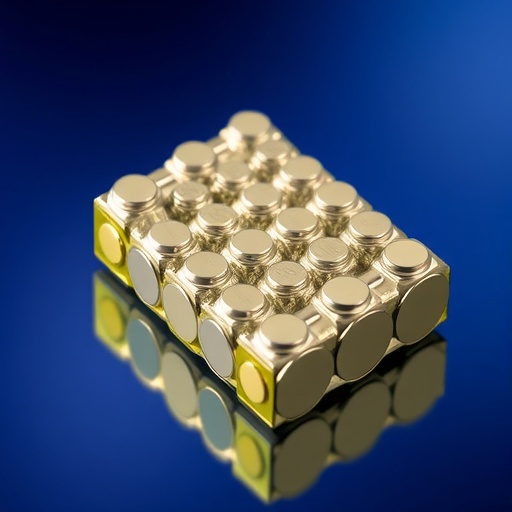In the realm of energy storage technologies, supercapacitors have garnered significant attention due to their exceptional power density, fast charging capabilities, and long cycle life. The latest advancements in the optimization of nickel cobalt sulphide (NiCo2S4) nanostructures have the potential to revolutionize the efficiency of supercapacitors. Recent research conducted by Siwatch, Sharma, Manyani, and their team, published in the prestigious journal Ionics, delves deep into this cutting-edge area, offering insights that could reshape the future of energy storage.
Supercapacitors are often viewed as a bridge between conventional capacitors and batteries. They excel in applications that require rapid charge and discharge cycles, proving invaluable in sectors ranging from electric vehicles to portable electronics. The introduction of nickel cobalt sulphide nanostructures provides an innovative material platform that enhances the electrochemical performance of these energy storage devices. With their unique properties, NiCo2S4 nanostructures present an attractive solution to some of the current limitations faced by traditional supercapacitor materials.
One major challenge in the development of supercapacitors lies in optimizing electrode materials. The performance of a supercapacitor heavily depends on the surface area, electrical conductivity, and electrochemical stability of the electrode. Nickel cobalt sulphide nanostructures stand out because of their high theoretical specific capacitance and excellent conductivity. The experimental section of the study reveals detailed methodologies employed to synthesize these nanostructures, with specific attention given to the manipulation of their morphology and size. These factors are pivotal in maximizing their surface area and interaction with electrolytes, both crucial for improved capacitance.
.adsslot_MCpeIDhP5K{width:728px !important;height:90px !important;}
@media(max-width:1199px){ .adsslot_MCpeIDhP5K{width:468px !important;height:60px !important;}
}
@media(max-width:767px){ .adsslot_MCpeIDhP5K{width:320px !important;height:50px !important;}
}
ADVERTISEMENT
Another key aspect of the research involves the electrochemical characterization of the synthesized NiCo2S4 nanostructures. The researchers employed various techniques to analyze their performance, including cyclic voltammetry, galvanostatic charge-discharge tests, and electrochemical impedance spectroscopy. These methods allowed for a comprehensive evaluation of the supercapacitor’s capacitance, energy density, and power density. The results demonstrated that with careful optimization, the nickel cobalt sulphide nanostructures could achieve remarkable charge storage capabilities, propelling them to the forefront of supercapacitor technology.
The use of nickel and cobalt in the synthesis process of these nanostructures is not without its environmental and economic implications. The researchers carefully consider the sourcing of these metals and how advancements can lead to more sustainable practices within the industry. The discussion spans the lifecycle of these materials, from extraction to disposal, underscoring an overarching goal of minimizing environmental impact while maximizing performance. This viewpoint resonates with the current global push for greener energy technologies, aligning with societal demands for sustainable solutions.
Innovation in energy storage technology is also bolstered by interdisciplinary collaboration. The study spearheaded by Siwatch and team exemplifies how chemistry, materials science, and engineering can converge to tackle complex challenges. By integrating cross-disciplinary knowledge, researchers are not only advancing the fundamental science behind energy storage but are also setting the stage for practical applications that can thrive in today’s technology-driven landscape. This synergy is vital for fostering continued innovation, ensuring that new materials and methodologies can be tested and optimized efficiently.
Additionally, the implications of this research extend beyond pure academic interest. Industries looking for advanced energy storage solutions can draw from the insights gained through this study. Manufacturers of electric vehicles, consumer electronics, and renewable energy setups could leverage the properties of nickel cobalt sulphide nanostructures in their designs, potentially leading to improved product performance and consumer satisfaction. The impact of such advancements could ripple across various sectors, driving competitive advantages for early adopters who invest in this technology.
Looking ahead, the study sets the stage for future research endeavors. While the findings are promising, continued exploration into the long-term stability and scalability of nickel cobalt sulphide nanostructures is necessary. Future studies could focus on their performance in different environmental conditions, their interaction with various electrolyte mediums, and their resilience in commercial applications. Understanding these parameters will be crucial for ensuring that these advanced materials can meet the demands of real-world usage over extended periods.
In conclusion, the optimization of nickel cobalt sulphide nanostructures represents a significant breakthrough in the field of energy storage. The work conducted by Siwatch, Sharma, Manyani, and their team not only opens new avenues for supercapacitor applications but also underscores the importance of sustainable practices within material synthesis. Their findings invite further exploration and innovation, fostering a future where efficient, reliable, and environmentally conscious energy storage solutions can flourish.
As the global need for efficient energy storage solutions continues to climb, the research into nickel cobalt sulphide nanostructures and their applications in supercapacitors becomes ever more pertinent. This groundbreaking investigation highlights not only the remarkable potential of these materials but also solidifies their position in the future of energy technology.
Subject of Research: Optimization of nickel cobalt sulphide nanostructures for supercapacitors application.
Article Title: Optimization of nickel cobalt sulphide nanostructures for supercapacitors application.
Article References:
Siwatch, P., Sharma, K., Manyani, N. et al. Optimization of nickel cobalt sulphide nanostructures for supercapacitors application. Ionics (2025). https://doi.org/10.1007/s11581-025-06534-4
Image Credits: AI Generated
DOI: https://doi.org/10.1007/s11581-025-06534-4
Keywords: energy storage, supercapacitors, nickel cobalt sulphide, nanostructures, electrochemical characterization, sustainability, material optimization.
Tags: electric vehicle energy solutionselectrochemical performance enhancementelectrode material developmentenergy storage advancementslong cycle life supercapacitorsnickel cobalt sulphide optimizationNiCo2S4 nanostructuresportable electronics power storagerapid charge discharge applicationssupercapacitor material limitationssupercapacitor technologysurface area and conductivity





